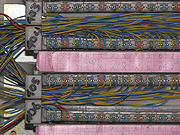
110 block
Encyclopedia


Punch block
A punch down block is a type of electrical connection often used in telephony. It is named because the solid copper wires are "punched down" into short open-ended slots which are a type of insulation-displacement connectors...
used to connect sets of wires in a structured cabling system. 110 is also used to describe a type of Insulation-displacement connector
Insulation-displacement connector
An Insulation-displacement connector, insulation-displacement technology/termination or insulation-piercing connector is an electrical connector designed to be connected to the conductor of an insulated wire or cable by a connection process which forces a selectively sharpened blade or blades...
used to terminate twisted pair cables which uses a similar punch-down tool as the older 66 block
66 block
A 66 block is a type of punchdown block used to connect sets of wires in a telephone system. 66 blocks are designed to terminate 22 through 26 AWG solid copper wire....
. It is available in two varieties: pairwise connections, with each row containing two electrically connected terminals (the left two and the right two); and rowwise connections, with each row of four terminals all tied together. This option must be specified when ordering.
Telephone distribution
Early residential telephone systems used simple screw terminals to join cables to sockets in a tree topology. Since about 2000, these screw-terminal blocks have been slowly replaced by 110 blocks and sockets. Modern homes usually have phone service entering the house to a single 110 block, whence it is distributed by on-premises wiringOn-premises wiring
In telecommunication, on-premises wiring is customer-owned communications transmission lines. It is also called customer premises wiring . The transmission lines can be metallic or optical fiber, and may be installed within or between buildings.Premises wiring may consist of horizontal wiring,...
to outlet boxes throughout the home in a star topology. At the outlet box, cables are punched down to standard RJ-11 sockets, which fit in special faceplates.
In commercial settings, this style of "home run wiring" was already in use on 66 block
66 block
A 66 block is a type of punchdown block used to connect sets of wires in a telephone system. 66 blocks are designed to terminate 22 through 26 AWG solid copper wire....
s in telecom closets and switchrooms. The 110 block has been slowly replacing the 66 block, especially for data communications usage.
Computer networks
The 110 block is often used at both ends of Category 5 cableCategory 5 cable
Category 5 cable is a twisted pair cable for carrying signals. This type of cable is used in structured cabling for computer networks such as Ethernet. It is also used to carry other signals such as telephony and video. The cable is commonly connected using punch down blocks and modular connectors...
runs through buildings, as shown in the image. In switch rooms 110 blocks are used to connect cables to patch panel
Patch panel
A patch panel or patch bay is a panel, typically rackmounted, that houses cable connections. One typically shorter patch cable will plug into the front side, whereas the back holds the connection of a much longer and more permanent cable...
s. At the other end 110 connections may be used with keystone module
Keystone module
A keystone module is a standardized snap-in package for mounting a variety of low-voltage electrical jacks or optical connectors into a keystone wall plate, face plate, surface-mount box, or a patch panel....
s that are attached wall plates. 110 blocks are preferred over 66 block
66 block
A 66 block is a type of punchdown block used to connect sets of wires in a telephone system. 66 blocks are designed to terminate 22 through 26 AWG solid copper wire....
s in high-speed networks because they introduce less crosstalk and many are certified for use in Cat5 and Cat6 wiring systems, even Cat6a.
Problems
During regular usage bits of wire can become stuck inside a 110 block, this renders that given pair unusable as new wire will be unable to make contact with the 110 block. A tool known as a spudgerSpudger
A spudger is a wiring tool used for poking or adjusting small wires or components, generally in the electronics and telecommunications industries....
can be used to remove the excess wire.
110 blocks are also less secure than 66 blocks for keeping cross connects in place.
See also
- 66 block66 blockA 66 block is a type of punchdown block used to connect sets of wires in a telephone system. 66 blocks are designed to terminate 22 through 26 AWG solid copper wire....
- Telecommunications Industry AssociationTelecommunications Industry AssociationThe Telecommunications Industry Association is accredited by the American National Standards Institute to develop voluntary, consensus-based industry standards for a wide variety of ICT products, and currently represents nearly 400 companies...
- Electronic Industries AllianceElectronic Industries AllianceThe Electronic Industries Alliance was a standards and trade organization composed as an alliance of trade associations for electronics manufacturers in the United States. They developed standards to ensure the equipment of different manufacturers was compatible and interchangeable...
- Electrical wiringElectrical wiringElectrical wiring in general refers to insulated conductors used to carry electricity, and associated devices. This article describes general aspects of electrical wiring as used to provide power in buildings and structures, commonly referred to as building wiring. This article is intended to...

